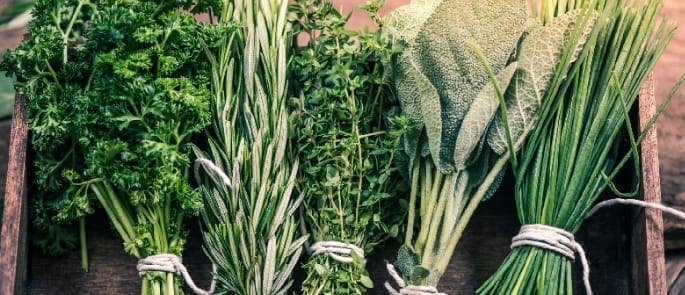What’s The Best Way to Store Vegetables?
Storing fruits and vegetables can be confusing. Different varieties have different best-before lives, and require certain storage conditions. Plus, it can be hard to tell when fruit and veg are no longer at their best (until you’ve already taken a bite). Ideally you want to store them right so there’s no second guessing. But what are the best storage methods?
This article offers you advice on the best way to store vegetables and fruit so they remain fresh and appetising for as long as possible.
This article is split into the following sections:
- How To Store Herbs
- Where Should I Store Onions?
- Where Should I Store Potatoes?
- Where To Store Bananas?
How To Store Herbs
Keeping herbs fresh past the stroke of midnight on their best-before date can feel impossible. But it’s not! It’s all about finding a balance to accommodate their delicate nature.

To lengthen the life of herbs:
- Keep herbs out of direct light. Light damages chlorophyll and causes herbs to turn yellow.
- Store herbs in the fridge or at least wrapped. Cold storage prevents exposure to oxygen (which turns herbs brown).
- An exception to this is basil, as well as other fragile herbs, as the cold can damage it. Keep basil at room temperature, with one of the storage methods below.
- Dry or wet paper towel wrap: wash the herbs, pat them dry with a paper towel, and wrap them in dry paper towels (or slightly damp paper towels if you don’t wash the herbs). Then, put the bundle in a zipper-lock bag in the fridge. This storage method is effective for hardy herbs such as sage, rosemary, and thyme.
- Store upright in water and zip-locked: snip the stems, wash the herbs, and pat them dry. Place the herbs upright like flowers in a pot, jar, or glass filled with a small amount of water (around 1/5th). Then, cover the exposed herbs with a zip-lock bag (zipped up to the side of the jar or cup) or use a deli food container with a lid to seal it. Finally, put it in the fridge (but avoid doing so if it’s basil). Change the water regularly.
With these methods, herbs like parsley, coriander, basil, thyme, and more can last up to 2 weeks or longer! You can even freeze or dry leftover herbs if you’ve been overzealous during your last shop.
Tips for drying herbs:
- Drying is more effective for hardier herbs, such as rosemary, thyme, and oregano. Fragile herbs like basil lose more of their flavour through the drying process. But drying can be done with any.
- Hardier herbs dried are great for dryer dishes like pizza and for garnishes, while the fragile ones can be used in wetter dishes like soups, stews, and sauces.
- You can dry them in the oven, but microwaving is often proven to be more effective, as it evaporates the moisture more directly and better preserves the flavour of the herbs.
- How to dry herbs in a microwave: pick off the herbs and spread them on a microwaveable plate that’s covered in paper towels. Microwave on a high heat for around 1-2 minutes for hardier herbs, and around 1 minute for fragile herbs. Put them back in if they need longer (i.e. if they’re not crumbly yet). You can then store them as they are, but may want to grind them into powder.
Dried herbs can last for months, providing you store them correctly. Make sure you keep them in an airtight, sealed container in a cool, dark area.
Tips for freezing herbs:
- Chop them up finely and freeze them in oil (e.g. light olive oil). Doing so helps preserve the texture and flavour much better than if you used water, and also prevents freezer burn. Plus, it’s easier to use them in cooking as they’ll melt quicker.
- Put the chopped-up herbs and oil in an ice cube tray. You can then empty the herb cubes into a zip-lock bag for storage if you want your ice cube tray back.
- Alternatively, freeze them in a zip-lock bag. Put the chopped up herbs with oil into a zip-lock bag and flatten it as much as possible. Leave a small bit of space open to squeeze out excess air before you zip it up fully.
As with most frozen food storage, you can keep your frozen herbs in the freezer for as long as you like. But the texture and taste may be lost over time. Jot a date on the zip-lock bag and use the herbs within a few months.
Where Should I Store Onions?
A lot of myths alongside facts exist about onions; some are true, others not so much. You may have read or been told that you shouldn’t store onions and potatoes together, and that cut onions become poisonous and unsafe to use anymore. One is true, and one is false. Can you guess which is which?

Tips for storing onions:
- Don’t store onions and potatoes together: this is true. Onions and potatoes release gases and moisture that cause the other to sprout quicker.
- Don’t store onions wrapped in plastic bags. The plastic restricts air circulation, which accelerates spoilage.
- Store onions on the countertop in a basket or bowl. The area should be well-ventilated and away from other veges, as the gases that onions release speeds up spoilage (but you can store them alongside garlic).
- Store sweet onions (those produced in early summer) in the fridge, wrapped individually in paper towels. They will last for a few weeks.
- To extend the life of onions further, try one of these storage methods:
- Hang onions up in cut tights: to start, chop off the legs of an old pair of tights. Put an onion in the foot of the leg, tie a knot, and add more onions in the same way until the leg is full. Then, hang up the bunch of onions in a cool, dry place. When you want to use an onion, untie the knot at the top, and repeat whenever needed until all the onions are used. Then you can refill it; and repeat! The onions can last for months this way if conditions are right.
- Store onions in a hole-punched paper bag: purchase some lunch-size paper bags, fold them up, and punch holes along each end. When you open the bag it should have columns of holes on each side. Then, fill the bag with a few onions (not too many as this constricts air circulation), fold over the top, and paperclip shut. Keep them in a drawer, cupboard, or shelf. If conditions are just right, they can last for up to 3 months!
Tips for storing cut onions:
- Do cut onions become poisonous and unsafe to use? No, this is a myth. In fact, onions actually have an acidic surface with sulphur compounds, which slow bacterial growth as compared to certain foods. They’re not immune though! Like with any other food, leaving them exposed for too long eventually leads to degeneration and contamination as it’s exposed to light and air.
- You can easily and safely store chopped onions after use. Put chopped onions into a zip-lock bag and/or Tupperware and store in the fridge. They can last for around a week before deteriorating in quality. Be sure the container is fully sealed to prevent the onion smell from tainting other foods!
- If you buy pre-cut onions from the supermarket, follow the storage instructions on the packaging. It’ll usually instruct you to keep the onions refrigerated and in their original packaging (you can transfer them to a zip-lock bag or Tupperware if you want).
You can even freeze onions. Just make sure to wash, peel, and chop them up, and put them in a freezer bag. Push out air as much as possible and make sure the bag is completely sealed (consider using Tupperware instead). Be aware that onions – especially when first frozen – smell strong, and the odour can leak out and taint other foods. So it may not be worth doing.
Need a Course?
Our Food Hygiene Courses are designed to ensure a comprehensive knowledge of all food safety and hygiene procedures.
Where Should I Store Potatoes?
Whether they’re home-grown or store-bought, there are plenty of ways to store potatoes to extend their life.
First things first: the best way to store vegetables like potatoes is to make sure the batch is all good. Potatoes with bruises, cuts, sprouts, and any discolouration may not last as long as clean, smooth, perfect ones, and may spoil the others. So keep them separate.

Tips for storing potatoes:
- Remove potatoes from plastic bags. Plastic constricts air circulation, so you should put the potatoes in a box, paper bag, or basket (covered in paper or similar to block light if kept on the kitchen counter) to maximise air circulation.
- Store potatoes in a cool, dark place. For example: in a cupboard (away from the sink). Make sure the potatoes still receive some air-flow though, so don’t put them in air-tight containers or drawers. A cupboard is better as it’ll have plenty of cracks. Store some kitchen bits in the same cupboard so you open it every now and then.
- Don’t put potatoes in the fridge. The cold temperature causes the potato starch to turn into sugar and taint the flavour.
- Don’t wash potatoes before storage. Excessive moisture speeds up spoilage.
- Keep potatoes out of sunlight to minimise sprouting and rotting.
- Keep potatoes away from other foods (especially onions as previously mentioned).
- You can cut away sprouts and green patches. The rest of it should still be good to eat, but if the sprouting is excessive then do throw the potato away.
If stored right, potatoes can last for many months! Be sure to check them every so often, and throw away any individual potatoes that are showing signs of rotting so they don’t spoil the rest.
Where To Store Bananas?
Fun fact: a preferred variety of bananas that’s been described as sweeter and creamier, known as the Gros Michel, went virtually extinct in the 1960 due to a fungus. It still exists in certain parts of the world, but is no longer produced on a large scale. The variant we eat today is known as Cavendish.

Knowing that doesn’t help you store your bananas though… so let’s move on to the tips!
Tips for storing bananas:
- Buy bananas when green to maximise their life. This is obvious, but easily overlooked.
- Store bananas away from other fruits. While ripening, bananas (and also kiwi fruit) release ethylene gas that causes other fruits to ripen and spoil quicker. But if you want certain fruits to ripen quicker, then do keep them together.
- Store bananas on a countertop at room temperature while ripening: somewhere away from too much moisture, direct sunlight, and overly-warm temperatures.
- Don’t refrigerate bananas while they’re ripening. The cold temperature inhibits proper ripening, even after they’re removed from the fridge.
- Warmth and sunlight speed up ripening, so if you don’t want this to happen keep them in a cool, dark space.
- Take bananas out of plastic bags. The plastic packaging holds moisture and can lead to the bananas spoiling faster.
- Wrap the stems of bananas in plastic wrap if you want to slow the ripening process.
- Hang up bananas on a ‘banana tree’ hanger. Doing so encourages air circulation and minimises ‘resting bruises’.
- When bananas are ripe, store them in the fridge. Once they are yellow and slightly spotted, they are ripe and ready to eat. After a few days in the fridge, the peel may indicate it’s overripe, but the fruit inside should still be good to eat for a week or more.
- Separate bananas from a bunch to help them remain at their prime ripeness.
Like anything, you can also freeze bananas. Peel them first (and chop them up if you want), then put them in a zip-lock bag or plastic container. Frozen bananas are great to use for smoothies and other banana-including recipes. But to eat as a healthy snack, bananas are best enjoyed fresh, so do use all the tips above to keep them at their best.
What To Read Next:
- How Long Does Food Last in the Freezer? A Storage Guide
- 17 Ways to Reduce Food Waste in Your Restaurant
- Understanding Factors Affecting the Shelf Life of Food Products
- Should I Store Open Food Cans In The Fridge?
- Food Preservation Methods and Guidance
- Level 2 Food Hygiene Training for Catering











